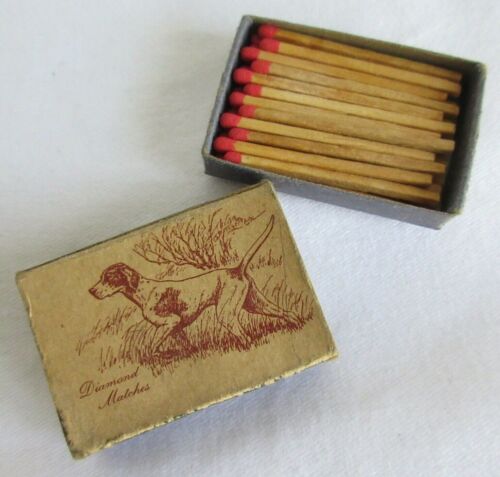
If you’ve collected old matchboxes or matchbook over the years and they’re collecting dust in a corner of the house, or you have them under glass because you really like them, you, dear reader, are a phillumenist, or a collector of matchbooks/boxes. If they all have images of dogs on them like the image seen at the top, you specialize in canine phillumenism.
Who knew?
The word, phillumeny, was invented by British collector Marjorie S. Evans in 1943, and is derived from the Greek “Phil” or love, and the Latin “Lumen” or light. As for the item itself, matchbooks (paper matches, stapled to cardboard and tipped with sulfur and phosphorus) were patented in 1892 by Joshua Pusey, a lawyer. The Diamond Match Company bought the patent in 1894, and Joshua Pusey found job security as he went on to become Diamond Match Company’s attorney for the rest of his life.
They used to be a common way for companies to advertise at a time when people smoked more (Pabst Beer ordered 10 million matchbooks in 1894 to feature ads for their beer , and later, tobacco maker Bull Durham did the same thing by ordering 30 million matchbooks to promote his tobacco).
Interestingly, the friction strip didn’t used to be on the outside. If you can imagine, early on, gritty strips were placed on the inside cover of a book of matches right next to the rest of the matches, and when someone ran a match head against the strip to ignite it, they often ended up ignited all the matches – and burned fingers. Enter Henry Truante who ordered the friction strip to be moved to the outside. He also added a warning label” “Close Cover Before Striking.” The warning remains to this day.
Matchboxes/book are highly collectable, in part because they were either free (they often sat in a bowl and came with the sale of a pack of cigarettes) or cost pennies when originally acquired. They’ve only increased in value. The hunting dog (Pointer) matchbox at the top is from 1952 and as of this writing, is listed on Ebay at a starting bid of $14.95. That may not seem like much, but by our calculations, this is a percentage increase of 29,900%, meaning the box is worth almost 300 times what it probably cost 70 years ago. A collector with hundreds of matchboxes or books in his or her inventory might not may off the mortgage with the increase in value; on the other hand, in 2015, someone paid $6,000 for a Charles Lindbergh matchbook made in 1927. You just never know.
Ebay and Etsy are great places to find dog match book and boxes. We’ve spotted Setters, Collies, German Shepherd Dog, a “King Charles Springer Spaniel dog” (huh?), Bulldogs, and more. It pays to do one’s diligence because today’s technology makes it easy to make what look like vintage items, but are not. Anyone with creativity, a registration jig, oil-based intaglio ink, and who can learn the woodblock printing process make their own, and while it’s a great project for a national specialty or for a fundraiser, buyer beware if you’re looking to invest in a hobby that has value potential.
Beware, too, that it can be an addictive hobby. One chap in the UK has a collection of 20,736 matchboxes and 1,054221 different matchbox labels from over 130 countries as of 2013. And yes, it made it into the Guinness Book of World Records. There are phillumenist clubs, auctions and swaps, and, of course half the fun is in the hunt which can take you into vintage and antique shops.
Once the Zippo lighter was invented in 1932, the market for matches shrank, and when smoking was revealed to be bad for one’s health in the 1970s, even fewer matchbooks/boxes were sold. The industry all but died, but like other vintage or rare items, it only makes the matchbook/box all the more collectable.
If this interests you, take a gander at this primer to get started.
